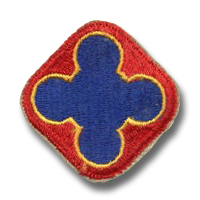If you do NOT see the Table of Contents frame to the left of this page, then
Click here to open 'USArmyGermany' frameset |
11th AAA Battalion (AW) (SP)
Tactical Command
Looking for more information from military/civilian personnel assigned to or associated with the U.S. Forces, Austria from 1945 to 1955. If you have any stories or thoughts on the subject, please contact me . . |
|
|
|
|
|
| |
| 11th AAA Battalion
History |
|
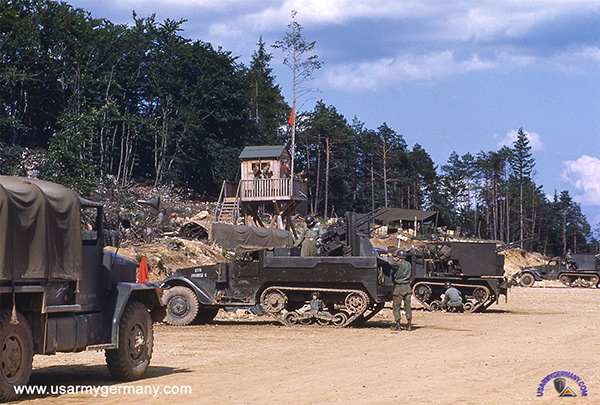
M-16 & M15 half-tracks of the 11th AAA Bn on a firing range at Hohenfels, Germany, June 1953 |
| |
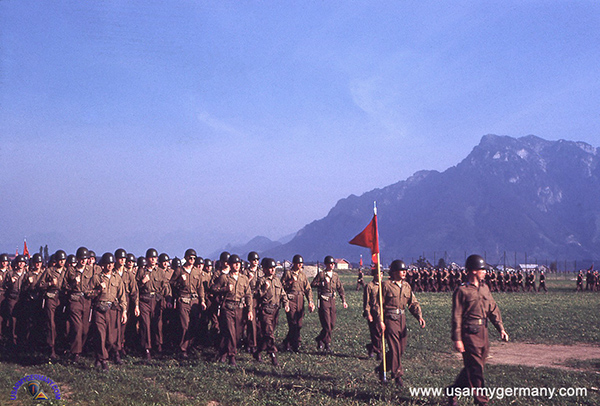
Retreat parade, 11th AAA Bn, 1952 |
|
|
| 1955 |
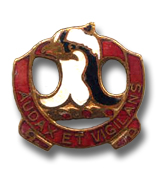 11th AAA AW SP Bn DI 11th AAA AW SP Bn DI |
| |
| (Source: Unit History "11th AAA BN (AW)(SP), April 1907 - March 1955") |
This unit history and several relevant photos were provided by Edward H. Lamers who resides in Browns Valley, Minnesota. The 11th AAA Bn was originally constituted in the Regular Army as 3rd Battalion, 66th Regiment, Coast Artillery Corps, and organized 1 March 1918 with Headquarters at Fort Adams, Rhode Island. Demobilized 20 March 1919 at Camp Upton, New York. Reconstituted 22 January 1926 in the Regular Army as 3rd Battalion, 66th Coast Artillery (Antiaircraft). Activated 8 March 1942 at Camp Buchanan, Fort Miles, Puerto Rico. Redesignated 25 August 1942 as 2nd Battalion, 66th Coast Artillery (Antiaircraft)(Automatic Weapons). Reorganized and redesignated 6 November 1943 as 910th Antiaircraft Artillery Automatic Weapons Battalion. (Returned to the United States and arrived at the New York Port of Embarkation 4 December 1943. Departed New York Port of Embarkation for service in Europe on 1 December 1944 and arrived in England 12 December 1944; landed in France on 14 February 1945. Returned to the United States and arrived at the New York Port of Embarkation on 9 February 1946.) Inactivated 10 February 1946 at Camp Kilmer, New Jersey. Redesignated 13 Octobver 1948 as the 11th Antiaircraft Artillery Automatic Weapons Battalion. Activated 15 January 1949 at Fort Bliss, Texas. (1st Battalion, 11th Coast Artillery reconstituted 28 June 1950 and consolidated with the 11th Antiaircraft Artillery Automatic Weapons Battalion.)
We now pick up their history in late 1950.... |
|
| |
On 15 November 1950, Major William Wyatt assumed command of the depleted Battalion (11th) and immediately began the arduous task of rebuilding the 11th Battalion. Filler personnel were received 30 November 1950 and began an intensified program of basic and advanced training.
For the next six months the 11th was busily engaged in unit training cycles with inspections, parades, reviews and firing sessions thrown in to round out the program.
During the month of June 1951 the long awaited orders arrived alerting the well trained Battalion for overseas shipment. July 1951 saw the 11th enroute to Camp Kilmer, New Jersey, for shipment to Austria. After undergoing a final orientation, the Battalion boarded the "General Callan"1) at the New York Port and departed on its ocean voyage, arriving without mishap at Leghorn, Italy, on 12 August 1951.
1) U.S.N.S. General R. E. Callan (T-AP 139)
|
|
| |
| |
The 11th Battalion received it's first view of Europe as it disembarked from the "General Callan" and departed Leghorn for Austria on Troop Trains. The 11th AAA Bn (AW)(SP) was the first unit to enter through the Leghorn port since the end of World War II and was met at the Pier by the Italian Navy Band and leading Officials of Leghorn as well as Officials of the United States Forces in Austria.
At noon on the 13th day of August 1951 the first of three troop trains unloaded at Camp McCauley, Austria, and by 2100 hours of that day the 11th Battalion had all arrived at its new home and were busily engaged in setting up housekeeping in its new billets.
The first few weeks at Camp McCauley were devoted to the usual routine details, such as setting up housekeeping, cleaning equipment and uncrating supplies shipped from Fort Lewis. However, it was not until September and October 1951 that the greater part of the vehicle equipment arrived in Camp McCauley.
Shortly after arrival the 11th was assigned to Tactical Command, United States Forces in Austria, and quickly earned a reputation as an outstanding unit.
For the first time since reactivation at Fort Bliss, the 11th had sufficient time to divert some attention to the field of sports. A Battalion football team was formed and, although new in the game, finished second in the Northern Division and swept the division playoffs by a 65-0 score and by the end of 1951 Battery Basketball teams had won 45 and lost 3 games to set another viable record.
Training during this time however, was not neglected, and a vigorous program was initiated. Men from all Batteries were sent to specialist schools and soon the Battalion was receiving commendations as men of the 11th returned as honor graduates from schools throughout Austria and Germany.
In November 1951 General Fry, Commanding General of Tactical Command, and his staff conducted the first Command Inspection of the 11th Battalion since its arrival in Austria. The results were superior. Also during November, the Battalion spent considerable time at Ramsau Firing Range engaged in ground firing activities.
Christmas of 1951 found the men of the 11th Battalion in fine spirits and in keeping with an old American tradition, planned and sponsored numerous parties for Austrian Orphanages and Old Peoples' Home.
In January 1952 the Battalion was literally "up to its tracks in snow" while receiving it's baptism to the much publicized Austrian maneuvers. This was "Exercise Snowshoe", and the Battalion, with the exception of Baker Battery, was a member of the friendly forces. Baker Battery participated as a unit of the proverbial losers; the Red Aggressor Forces.
In March 1952 the IG Inspectors descended upon the 11th in force, but they were unable to uncover any major deficiencies and the reports that followed showed the Battalion to be the highest rated battalion size unit of the United States Forces in Austria.
On 1 April 1952 the Battalion departed Camp McCauley and arrived the same day in the newly established Camp Roeder, located just outside of Salzburg, Austria, along the Autobahn. |
|
|
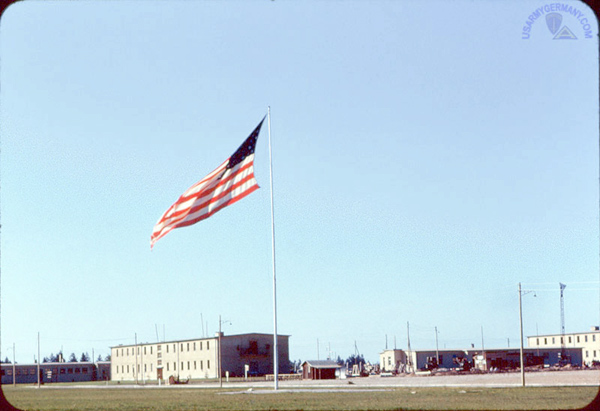
Old Glory over Camp Roeder, March 1953 |
|
| |
| |
| |
Camp Roeder, at the time the 11th arrived, was nothing but a group of buildings surrounded by a sea of mud, with some of the buildings in the Battalion area still with the scaffolding on them. However, the 11th with their indomitable spirit set about to make a new and livable home for themselves.
On 16 June 1952 Lt Col John E. Wales III, assumed command of the Battalion. Major Wyatt was reassigned to Headquarters Tactical Command.
The summer of 1952 was uneventful, full of being devoted to training, maintenance, and frequent field problems. The emphasis on the field problems was the art of learning to work in close liaison with the Infantry in ground support missions. During the spring months, the Battalion Track team placed second in league competition. In the summer, the Battalion Baseball team further added to the Battalion's laurels by winning the Salzburg Military Post League Championship and went on to take the USFA title.
In September the Battalion moved to the Grafenwoehr Firing Range in Germany for some much needed firing practice by all combat vehicles. This was followed during the month of October by the Field Forces Firing tests held at Hohenfels, Germany. Although firing on a strange range and under adverse weather conditions the results were impressive.
During the month of November 1952, the Battalion again joined the Friendly Forces in "Operation Frosty". During this exercise units of the Battalion participated ion a variety of missions, both in direct support of friendly infantry forces and in protection of certain vital supply installations and routes. Severe weather and a strong and determined "Aggressor" combined to tax the unit's ability under most difficult conditions. Superior training and equipment of the friendly forces finally repelled the Aggressor as units of the Battalion supported a final drive on Frankenmarkt, Austria.
The following months were devoted to training, maintenance and field problems, with sufficient time out to celebrate the Christmas holidays and to enjoy the many skiing and recreation resorts in the vicinity.
(On 1 February 1953 the Battalion was redesignated as the 11th Antiaircraft Artillery Battalion (Automatic Weapons) (Self-Propelled).)
In February 1953 the IG Inspection team of USFA again descended upon the 11th Battalion and from all indications the Battalion was again rated as outstanding.
Colonel John E. Wales III, left the Battalion in August to return to the United States. Major Frederick K. Schmidt assumed command of the Battalion pending the arrival of Colonel Wales' replacement.
In September the Battalion underwent the Tactical and Detection Phases of the Field Forces Test and, upon completion of the tests, went immediately to Hohenfels for another session of AA firing.
Lt Colonel David A. Gile assumed command of the 11th AAA Battalion on 3 October 1953 just in time to take the unit on the USFA Fall Maneuvers, "Exercise Mudlark." Once the exercise got underway Colonel Gile saw neither the battalion nor sleep until the end of the exercise. As usual in maneuvers the "Freeland" forces won, but the issue was in doubt until the very end.
The battalion swimming team won the 1953 Salzburg Military Post swimming championships and was kept from winning the USFA honors only due to the fact that there were no team championships held by USFA. However members of the swimming team won most of the honors in the USFA individual swimming championships.
The Battalion football team salvaged a losing pigskin season by defeating the 510th FA Battalion 27-14 to win the USFA Artillery Championship.
"B" Battery won the Roeder Softball League Championships.
As winter approached, plans for Austrian Christmas parties were made and each battery gave parties for Austrian Orphans. "C" Battery again won the prize for the best outdoor Christmas display.
The Headquarters Battery Basketball team won the Artillery-Signal basketball championship, although eliminated from the USFA championships. This marked the third straight year that the Headquarters team had been undefeated in league competition.
1 July was designated as annual organizational day for the 11th AAA Battalion.
During the period 8-20 March 1953 the unit went to Grafenwohr, Germany, for AA firing. During this period individual weapons were fired for familiarization.
After an overnight stop at Camp Roeder, the Battalion departed for the field to participate in Tactical Command's spring exercise, "Webfoot."
In June 1954 "A" Battery obtained new billets in Wels, Austria. This change enabled Headquarters Battery to regroup and to obtain residence of their own after spending two years with close relatives. They were barely settled in their new home when on 12 June the battalion again went to Hohenfels for AA firing. June also saw the departure from the 11th of numerous officers and men who had been members of the unit since 1949.
The unit history appears to end here. The Battalion was inactivated 30 August 1955 at Camp Roeder, Austria. The unit was reorganized and redesignated 29 February 1956 as the 11th Antiaircraft Artillery Battalion (NIKE). Activated 2 April 1956 at Fort Hancock, New Jersey. Inactivated 1 September 1958 at Manchester, Connecticut. |
| |
|
|
|
|
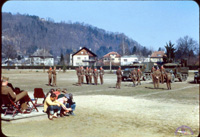
1. Gun drill |
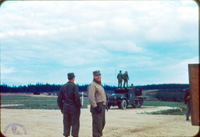
2. More training |
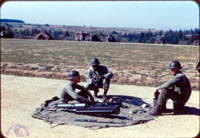
3. Equipment maintenance |
|
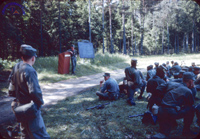
4. Class in the woods |
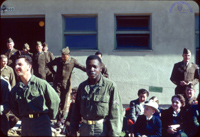
5. Pie eating contest |
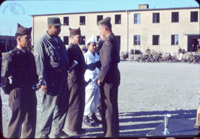
6. Lt Col Wales III, Bn CO |
|
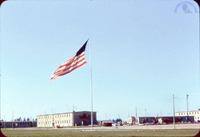
7. Old Glory over Camp Roeder |
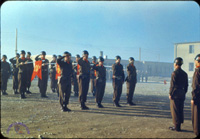
8. Officers Center |
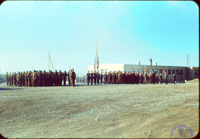
9. Retreat parade, March 1953
|
|
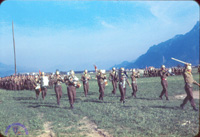
10. 11th AAA Bn Band, 1952 |
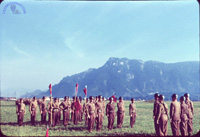
11. Bn Staff and Btry COs, 1952 |
|
|
|
|
| |
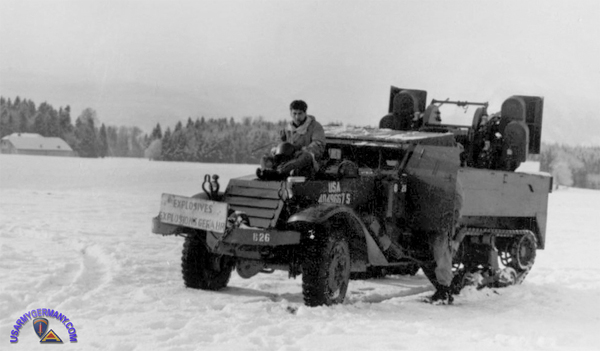
"B" Battery M16 with Quad 50 cal machine guns during a field exercise (Webmaster's collection) |
| |
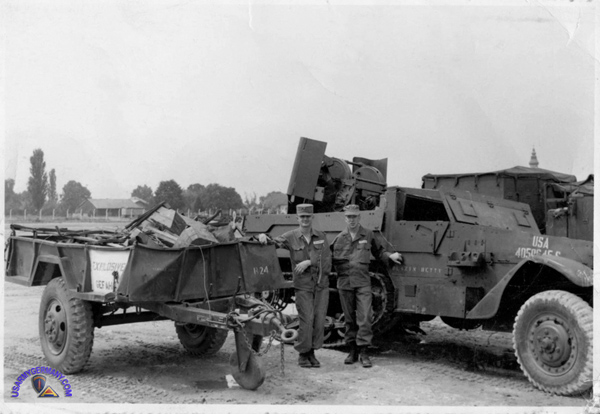
Two 11th AAA Bn soldiers at the salvage yard (Webmaster's collection) |
| |
 |
|
| |
Related Links:
|
| |
| |
|
 11th AAA AW SP Bn DI
11th AAA AW SP Bn DI 

